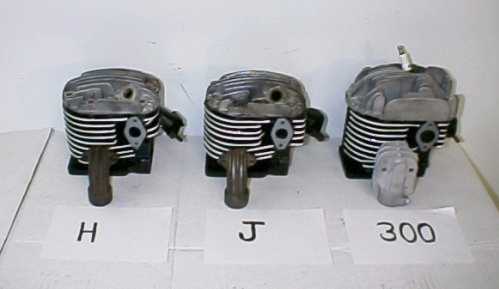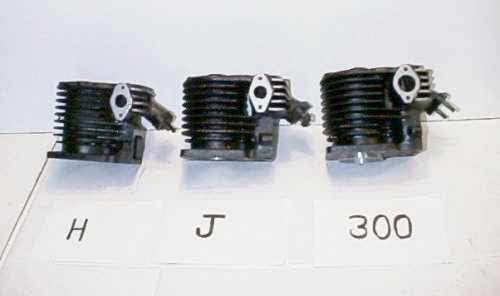| Intro Page | Start 'er Up |
Well I Got This Big Box Full of Engine Parts and.......
Oh WOW! Well..lets see... Look at the crankcase. On the oil sump below the flywheel there is a number cut in with metal stamps. If the serial number starts with "H" it is a 46/47 or early 48. (The 100,000 "H" was made in August of ‘47) If "J", it is a 48/49. (50,000)to November 49. 300 indicates ‘49,’50 and 51, and 700 is a 1952 model. 300 xxx"S" and 600 xxx"S"means it has a kick-starter. (There were only about 50,000 combined total of 300, 300S, 500, 600S, and 700 motors) ...Whizzer was prone to skipping blocks of serial numbers, and that plays havoc with trying to count the engines.
If the head is low fin with the spark- plug hole to the left of center, and has a half- round "F" shaped combustion chamber it is off an "H" or a "J". If the bolt holes are 1/4 inch it is an early "H", 5/16 hole is off a late "H" or a "J" engine. If the head is high- fin, with a triangular combustion chamber and the plug is to the right of center, it is off a "300" or later engine.

HEADS
The "H" cylinder has 3/4 inch valves. The bottom of the intake flange is about 1/2" away from the fins. There are four cooling fins on the cylinder at the rear where the valves go up. The head bolts may be 1/4 inch in diameter, or 5/16 inch in the later engines. The intake port is .760, and the exhaust port is .675 in diameter. (A dime will go in the intake, and will nearly go in the exhaust.) The carburetor studs are 1 5/8 apart. There is a number cast into the cylinder base on the right side
The "J" cylinder also uses 3/4 inch valves, but there is no space between the intake flange and the fins at the bottom. The intake port is .850 ( A nickel will go in). The exhaust port is .750 (dime size), and the head bolt diameter is 5/16 inch. There are five fins at the rear. The carburetor studs are spaced for the Carter carburetors, and are 1 13/16 apart. There is no casting number on the cylinder base.
The "300" and "700". Engines use 7/8 inch valves, and the ports measure .850 intake, and .875 exhaust. ( A nickel goes in either, and a quarter will nearly go in the exhaust.) There are five fins at the rear. The intake is right up against the cylinder at the bottom. If there is a number, it is stamped into the base of the cylinder.

CYLINDERS
* I have seen a number of "H" and "J" cylinders re- cut with 7/8" valves, either to increase performance, or maybe because the original seats were burned out. Some are also ported at the exhaust outlet. You can increase them to nickel size, but not quarter size, as there isn't enough metal there.
(People who race small engines tell me if you want high top end, use a small intake valve and a large exhaust valve. If you want bottom end performance, use a large intake valve and a small exhaust valve.)
An oil breather measuring 2 5/8 from bottom to top is off an "H" or a "J" engine, and a tall one measuring 3 7/8 is off a later 300 and 700. These can be used on the "H" and "J" to increase oil capacity to 8 oz., which is an advantage.

Performance Package
If the crankshaft is a one piece forging, it is an insert crank The standard journal is .999, and the right end should measure .750. If the crank is made up of pieces pressed together, it is a needle- bearing crank. They were produced in Germany in 1953 as an aftermarket item and are valuable. The connecting rods are not interchangeable between the two.

A roller crank.
The crankpin is visible through the end of the throw. The roller crank is metric, as are the bolts.(5mm)
Kits for rebuilding roller cranks are available.
The cams, tappets, coils, and flywheels are the same for all engines. (Except for the flywheels off the 300S, 600S and 700 engines, which have no magnets, and the cams for these, which have magnets for the built in alternator in the side- cover.)
Practically all of the parts are interchangeable, for the most part, between engines. The dimensions of all the crankcases were the same, and almost everything fits everything else. Whizzer introduced new parts as improvements were made, and incorporated them in both the OEM and spare parts inventory, sometimes right in the middle of a production run.